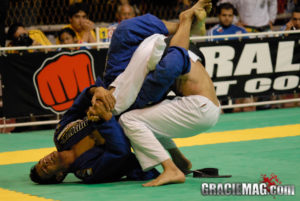There are a number of reasons Brazilian Jiu-jitsu works so well in the real world. From training methods, to emphasis on always assuming the opponent is bigger, stronger, faster, tougher (which makes the art usable for the smaller and more physically weaker practitioner), to always working against a resisting opponent who is free to do anything back, BJJ has always been able to prove that it works in any context or in any circumstance, whether that is a rules constrained sporting endeavor or an anything goes life or death struggle for with life and death stakes.
However, in my opinion, the feature that may be the biggest factor in jiu-jitsu’s real world efficacy is that it takes a mentally methodical approach to fighting. This is in stark contrast to the typical martial art/combatives approach to being technique focused, and with an emphasis on the end-state (note the push in combatives circles for the big cool move such as cycling hammer fists). The big problem with this way at looking at the fight ignores all the things that happen prior to being able to execute the big flashy move that looks so great on focus mitts. If you try to “win” the fight, there is the chance you will lose because you have opened up a window of vulnerability that the other party takes advantage of. We have all seen the UFC fight where a fighter is winning, and in a rush to finish with the spectacular knock out or the great looking submission gets caught while doing so and gets KO-ed or choked out himself. Almost every UFC has an example of this on some level.
BJJ on the other hand focuses on executing a methodical step by step approach that keeps you from having that window of vulnerability. There is a mantra in BJJ that every practitioner has heard thousands of times and that is POSITION BEFORE SUBMISSION. Essentially what this means is to have good positional dominance and control before thinking about the finish. That keeps you conscious, mobile, and in the fight, and allows you to go to the correct ending move without risking yourself losing.
For example, let’s look at a scenario where you have been taken down and your guard passed by an opponent who is now in top side control. In the standard martial art/combatives reaction to that, you will start desperately trying to pull off some escape, and what happens time after time is that in doing so, the opponent secures a better more dominant position, or even gets the submission or knocks out or is able to use a weapon. The BJJ principle is to make sure you are safe in the moment. Orient to the opponent, make sure your head and neck are protected and keep your limbs from being controlled. Once those things have been done, you can then look to create the space needed to escape, but you never arbitrarily give up your neck/head, limbs, or turn away in doing so. When you create the right space, you move to either a neutral or superior position. And even then, when you have reached either of those, you do not forget the idea of being safe. Again, protect that position before you go for the finish.
Here is a short video that gives you an idea of how this can look:
Remember, before we can “win”, we must not “lose”. Throwing away that concept puts you in a risky situation.
While you can see these concepts in any good BJJ match, sometimes things move too fast to see. One of the best places to see it in action and that is easy to follow is this match from 2015 between Roger Gracie and Comprido. Both are two of the finest competitors in jiu-jitsu history (Roger may very well be the greatest ever), and this match is a true showcase.
Notice how Roger reacts to getting taken down. He knows he is now down two points. He does not panic, nor does he flail away. He makes sure he has some control over Comprido to make sure he does not end up in a worse position, and then he establishes a solid closed guard. Then note at the 3:20 mark how he begins to set up the armdrag. He does not jump to it, but instead makes sure his position and control are solid, and focuses on preventing Comprido from moving his elbow away. Watch how when he does get the drag, he locks everything down before moving to the next step. He does not rush to the sweep, but rather methodically increases his dominance. After the sweep, Roger gets to a solid base and only then does he start to look for the finish. And even when the first choke fails, he does not desperately cling to it or wildly go for something else. He resets the dominant control, and then gets a second choke that ends the fight. A completely masterful example of the step by step process from bad situation to submission win by Roger, and a perfect representation of BJJ.
The beauty of this approach is that it works in any context – competition, self-defense, and just training, and for anyone, whether you are an elite athlete or just an everyday person trying to fit training into a busy schedule.

